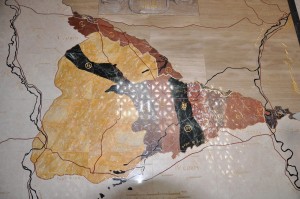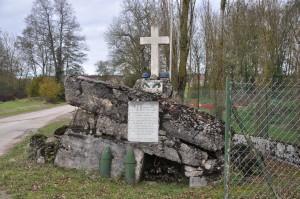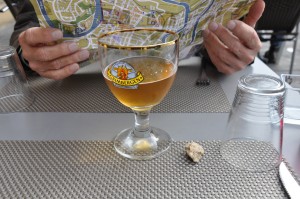The best laid plans may go awry but small inconveniences, what the French road system terms déviances, provide marvelous surprise. We could not have planned such adventures; we did not know that these were things we would want to do; we were in general completely ignorant of our options. Serendipity is what they call it; fantastic good luck is what it felt like to me.
We had to move out of the “relevant” territory to find a gîte and found the Saint Mihiel Salient.
I had some sense that Bar-le-Duc was the perfect location for the first week of our adventure. It was a town I wanted to visit; small towns with their boulangeries and charcuteries and other shops are great places to settle in; I had some sense that it was central to the places we wanted to see. Wrong on most counts. What we really wanted—and had no idea we wanted—was a place from which to explore the Saint Mihiel Salient. We needed to understand the situation in 1914-1915 and the German strategy in terms of Verdun to provide a context for the American Expeditionary Force in general and Grandfather David’s experience in particular. We only needed to be close enough to Liffol-le-Grand and Bar-le-Duc to drop in for a visit.
And who knew the twin capitals of Lorraine, Gallic Nancy and Germanic Metz would be such good fun; neither city was on the “to-do” list.
Gîteless for one night, we headed for a b&b and had time for a swing through the museum at Fleury-devant-Douaumont in the hills outside Verdun, a place of fascination and terrible sorrow.
We spent three weeks on the Pop Trail in 2002, using highly detailed Série Verte maps to get from tiny village to even more obscure localities mentioned in Pop’s journal and letters. We matched modern terrain to postes, battles, and cantonments. We explored Morte Homme and Hill 304 and even made it to Wassy for a reunion with the DuPotets, whose father Bernard and Pop enjoyed a lifelong friendship. We went into Verdun, saw something of the trenches around Douaumont and went into the Ossuary; this museum, however, was not something we remembered. My Dear One had read about it, however. It is an extraordinary collection of artifacts, narratives, videos and starkly disturbing messages. There were personal connections, too. In the section focused on medical realities, there was a reference to the American Ambulance Field Service along with a photograph of some drivers and a bus. I peered at it. It was an ambulance from Section 2. In May 1917 Pop and a pal strolled the ten or twelve kilometers from Dombasle to Verdun, and ended the day with a visit with members of Section 2. We had only half an hour before it closed for two hours for lunch, but that thirty minutes felt eternal.
Our b&b the 4 Collines was in a chunk of farmland southwest of Charleville, a town we hoped to add to our loose itinerary. Google Maps suggested also that the route from Charleville to our next destination was more interesting and involved less highway than the route from our tiny village of Hagnicourt. This was a twofer as serendipity goes.
Charleville-Mezières has got to be the most adorable town in eastern France. I knew about this place; Pop was stationed near here after the Armistice and spent considerable time driving officers around and doing errands that seemed important to one army or another. In a letter to his folks in December he wrote: We’re working almost as hard as we ever did carrying civilians back to their homes in the evacuated territory. The runs are long and difficult and the cars are falling to pieces. Everyone is grouchy and ready to fight. The little discomforts of this life are becoming unbearable. Oh, how we want to get back! It’s might[y] hard to be patient.
Today Charleville is a bustling bourgeois place. We saw only the Place Ducale, a vast cobblestoned space framed by 17th century buildings, not too far from the river. It is home to an internationally famed puppet museum and festival, which we did not experience, and the Musée Rimbaud, which we did. Downstairs was the narrative of the poet’s life and shelves of editions published in his lifetime and after. Upstairs were temporary exhibitions, two of which were inspired by Rimbaud and his travels. The third exhibition, photographs made in the early 1960s by John Cohen, were Rimbaud through the lens of Bob Dylan and the Beats. Some of these odd snapshots—for that is what they really were—followed Bob Dylan here and there. Others focused on the antics of Allen Ginsberg, Greg Corso, Jack Kerouac and a handful of painter-friends: Alice Neel, Alfred Leslie and Larry Rivers.
It was a perfectly beautiful day. During lunch a piece of mortar dislodged from the façade of the ancient building and landed on the table adjacent to us, startling both us and the couple sitting there. When I remarked that it was un souvenir the husband smiled and gave it to us to keep. Gold leaves drifted down around us as we walked along the river headed back to the car.
Serena’s satellitical insights got us from Charleville to Hauteville in the Pas-de-Calais over hill and dale pretty much as we expected. The landscape, still a stretch of fields punctuated by villages, changed as we drove. The rich soil and arching sky of Lorraine became the forested land of the Ardennes and then the hillier, more rugged terrain of Picardy. At some point houses of stone gave way to houses of brick and the names of towns took on a Flemish flavor.
We noticed a sign for the Musée Matisse and wondered about that. My Dear One asked if Matisse were born in this area; perhaps it was the natal homestead? I seemed to remember that Matisse was born somewhere outside of Paris but I certainly could not recall where. We entered the comparative metropolis of Le Cateau-Cambresis around half-past four. Streets were fairly busy, shop lights were on, there was quite a bit of traffic. Suddenly a large banner trumpeted “Musée Matisse” and we could see a large courtyard with sculpture. We parked and walked back. The museum was open until six, so we went in. The building, the collections, all of it, left me, as the English say “gobsmacked.” This was Matisse’s gift to his hometown, an encouragement to find beauty even when surroundings appear drab. Matisse had found beauty in the lace and silk textiles that constituted his father’s family business. I will never look at those painted patterns and colors again in quite the same way. A wing is devoted to the art of Auguste Herbin, an abstractionist who worked through cubism and color to find his own spiritual sense of form.
Our arrival in Hauteville at gîte Les Tilleuls was put off another hour and we arrived under a sunset of nacreous rose and blue. It was another unexpected gift.
Who knew we would experience all these things?





